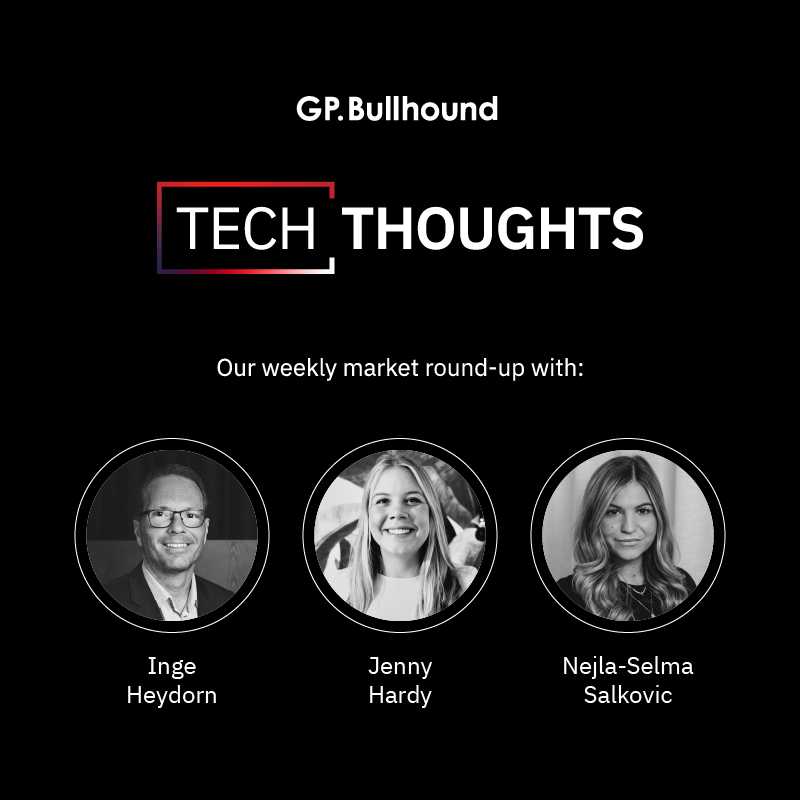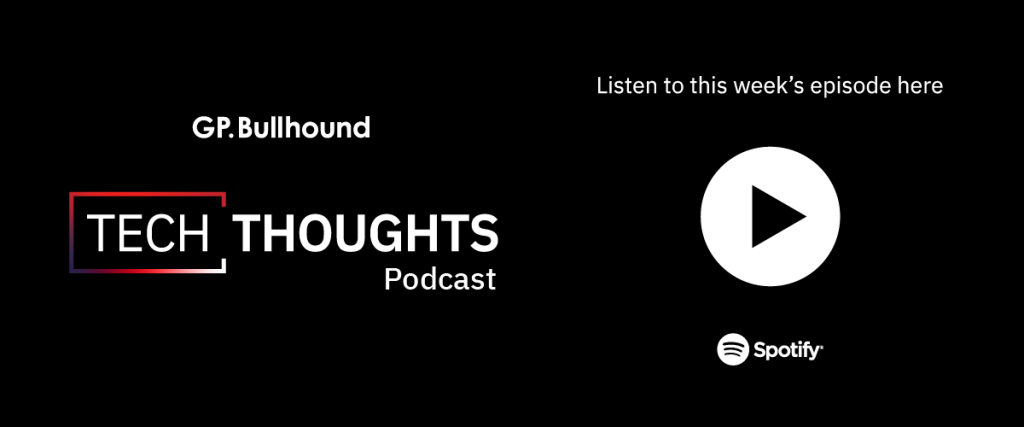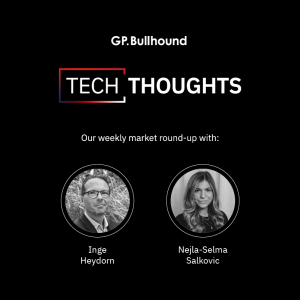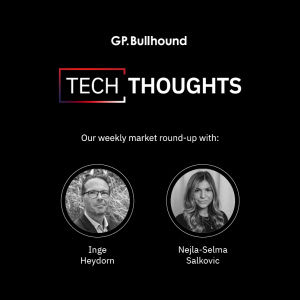Tech Thoughts Newsletter – 12 May 2023.

Market: The market continues to worry about the macro and whether we’ll see further deterioration during the second half of 2023. This is being played out in bank and real estate worries while Tech has done relatively better driven by lower interest rates. Tech has also been helped by large cap names reporting generally solid Q1 results.
Portfolio: We have not made any major changes to the portfolio this week.
AI was the focus in tech again this week, as Google/Alphabet (owned) held its I/O developer event, which sent shares up 10% over 2 days.
After some PR mishaps from Google this year around AI, we thought this was much more impressive and much more showcasing our view that Google is still leading around its core AI capabilities and technology. It was also a reminder of the number of touch points Google has with users upon which it can build AI features – with demos across photos, maps, email and Workspace – which are all opportunities to reinforce Google’s competitive advantage. Search remains a big debate and so far this year, the market has viewed AI as a threat to Google’s search business via competing Bing/ChatGPT. For us, to the extent that AI can provide a better user experience in search, we think it’s much more likely it will help Google reinforce its dominance.
In the very short term, we still think that one of the most obvious ways Google is benefitting from AI is in deploying generative AI to its advertising business – at its last results, it talked about using natural language AI to improve the relevance of ads shown when there are multiple overlapping keywords eligible for an auction. Applying AI it to its own very big search business on the advertiser side will arguably be one of the most financially meaningful deployments of AI in the market right now.
There was clearly some posturing of Bard vs ChatGPT – again, we think it’s a bit of a side show (for Microsoft we think much more interesting in AI is their enterprise and cloud opportunity).
Bard is different in that it is connected to the internet in real time – that has likely required a significant amount of hardware already deployed at Google. So that AI infrastructure arms race is now in full swing – and as we’ve commented before that will benefit Nvidia, AMD, TSMC…
Relatedly, Digitimes reported that Nvidia had increased orders for AI chips that require TSMC’s CoWoS (chip on wafer on substrate) advanced packaging by about 1,000 wafers per month – another sign that AI investments are picking up.
Onto results:
Iger’s streaming challenge
- Disney (owned, small position) – headline numbers were in line on EPS, and very slightly ahead on revenues but the details around streaming are still the most important and those were mixed.
- The headline loss for the DTC (streaming) business was better (-$650m vs the guided -$850m) so a narrowing of losses by $400m qtr/qtr.
- That profitability was helped by APRU going higher. Disney’s ad version was introduced at the same price as the prior ad free version which allowed them to raise prices – and positively (like we heard from Netflix) that price lever will continue
- On the negative side, though, subscribers are declining. That is quite a big issue because that very large content cost Disney is spending needs to be amortised over a larger subscriber base to make the maths around the streaming business work
- Iger’s message on the call was still that that streaming needs to get to sustainable profitability – and the cost cutting message across the business continues.
- Streaming still feels like a really tough business, and it’s hard not to view the presence of Amazon, Apple, YouTube as the big behemoths (who don’t necessarily need to make profits in that category) as a very big negative to the path to profitability and the sustainable level of profitability.
- We’ve spoken before that we might prefer Disney to focus on its differentiated (predominantly Disney) content, or even take the Sony approach and be a content seller – but that is certainly not the path Iger set up for the business 3/4 years ago, nor the one we expect him to take now.
- Indeed, it sounds like Disney are now much closer to buying the remaining Hulu stake than selling, integrating it as part of a “one app experience”.
Portfolio view: we own Disney but a small position after we trimmed last year around concerns around the competitive environment and high content spending. Broadly we question the long term returns within the streaming sector – and for Disney still wonder what Iger can do in terms of a strategy pivot and more cost cutting.
PC numbers – bouncing along the bottom…
- April monthly numbers from Taiwanese ODMs (Compal, Quanta), generally came in in line and it looks as though sell in may finally be catching up with sell through as inventory digestion abates
.. and Smartphone is still showing weakness
- The biggest negative in the monthly numbers were Mediatek, who reported much worse April numbers than we expected, down 46% yr/yr and down 34% mth/mth
- Generally we wonder whether, given the stronger March numbers we saw, inventory was built across the value chain in anticipation of stronger end demand – which hasn’t come through, and is now resulting in more inventory woes, or at least a more drawn out correction
- Skyworks reported and spoke of continued weakness in the Android ecosystem (we think especially China) as it continues to destock inventory
- Global Foundries (who are especially exposed to Handsets) also spoke to a longer inventory correction than they had previously expected – continuing into H2.
- The brighter spot for them was still autos which will more than double yr/yr this year
- GlobalFoundries’ own inventories and inventory days also increased (like Mediatek last quarter) which we continue to monitor – broadly it does feel as though we’ll see a more drawn out inventory correction and not the Q2 bottoming that had been guided at the start of the year.
- SMIC’s guidance was relatively better, with H1 expected to the trough of revenue decline, and news that 40-28nm has recovered to full utilisation.
Portfolio view: There are a number of moving parts in the smartphone space, with Apple potentially moving its target build (Qualcomm last week); while Samsung’s S23 is selling well. The unknown which we think is doing much worse is China, where we still don’t think we’re seeing a meaningful recovery in consumer demand
TSMC’s April revenue was up slightly month/month – picking apart the weaker smartphone numbers from Mediatek (a big TSMC customer), would imply datacentre revenues picking up for them which is another positive datapoint to our AI investments/arms race thesis.
Auto OEMs – still semi shortages, strong structural shift to EV
- Toyota reported its full year results this week – important as the number 1 car producer in the world. It expects 37% of its sales to be EV next year, vs 30% in the year just reported (to March 2023). It it still seeing some supply constraints in semis.
- That was reflected in Rivian CEO’s comments that “power semiconductors is still our biggest constraint”.
- While China smartphone is showing little signs of recovery, we think auto demand in China (particularly for EVs) is still strong – with subsidies coming off seemingly having no real impact – April production and sales were up 77% and 83% yr/yr and production and sales of EV more than doubled yr/yr
Portfolio view: We continue to prefer exposure to auto and industrial components vs smartphone/PC. Not only are demand trends better, the competitive barriers to entry are much higher as auto semis get designed in over much longer periods of time, with long term pricing agreements becoming a standard feature. In the smartphone/consumer space SMIC for instance has large amounts of capacity coming online – the reality is that much of consumer semis is relatively undifferentiated and pricing can deteriorate rapidly with increased supply.
Cyber security software demand holding up better
- Zscaler positively preannounced which helped cyber software sentiment – they now expect results above the high end of the previous range, helped especially by their Zero Trust product. It bodes well for Palo Alto, which we own, which plays in the same space, and the cyber security software landscape more broadly, where discounting and competition has been a fear.
Semicap structural demand trends continue
- We joined a call with ASML (owned) CFO this week, which was pretty consistent with what we’d heard at results: demand still exceeding supply across both EUV and DUV (backlog ~2x this year’s system sales) and very much seeing the structural demand driver related to tech upgrades and tech leadership continuing, as well as the still strong Chinese demand at the trailing edge.
- Tokyo Electron also reported its full year (March year end) results, beating guidance. They guided for a dip in revenues in March 2024, which is no surprise, and TEL is particularly exposed to NAND which will be especially weak. Positively though, management were very explicit in expecting a strong recovery in CY2024, in line with our expectations.
Portfolio view: We still like semicap equipment as oligopolistic businesses which are still seeing strong FCF generation and margins and which we expect to benefit from strong secular growth trends in 2024 and beyond.

For weekly insights on the latest market updates, please subscribe to our Tech Thoughts podcast.
For more information about the latest trends and forecasts, please visit our official Tech Thoughts page.
We provide investors with access to category leading technology companies, globally. Our assets under management have a total value of more than $1bn, and our limited partners include institutions, family offices and entrepreneurs. Learn more about our funds here.
Enquiries
For enquiries, please contact:
Inge Heydorn, Partner, at inge.heydorn@gpbullhound.com
Jenny Hardy, Portfolio Manager, at jenny.hardy@gpbullhound.com
Nejla-Selma Salkovic, Analyst, at nejla-selma.salkovic@gpbullhound.com
About GP Bullhound
GP Bullhound is a leading technology advisory and investment firm, providing transaction advice and capital to the world’s best entrepreneurs and founders. Founded in 1999 in London and Menlo Park, the firm today has 13 offices spanning Europe, the US and Asia. For more information, please visit www.gpbullhound.com.

